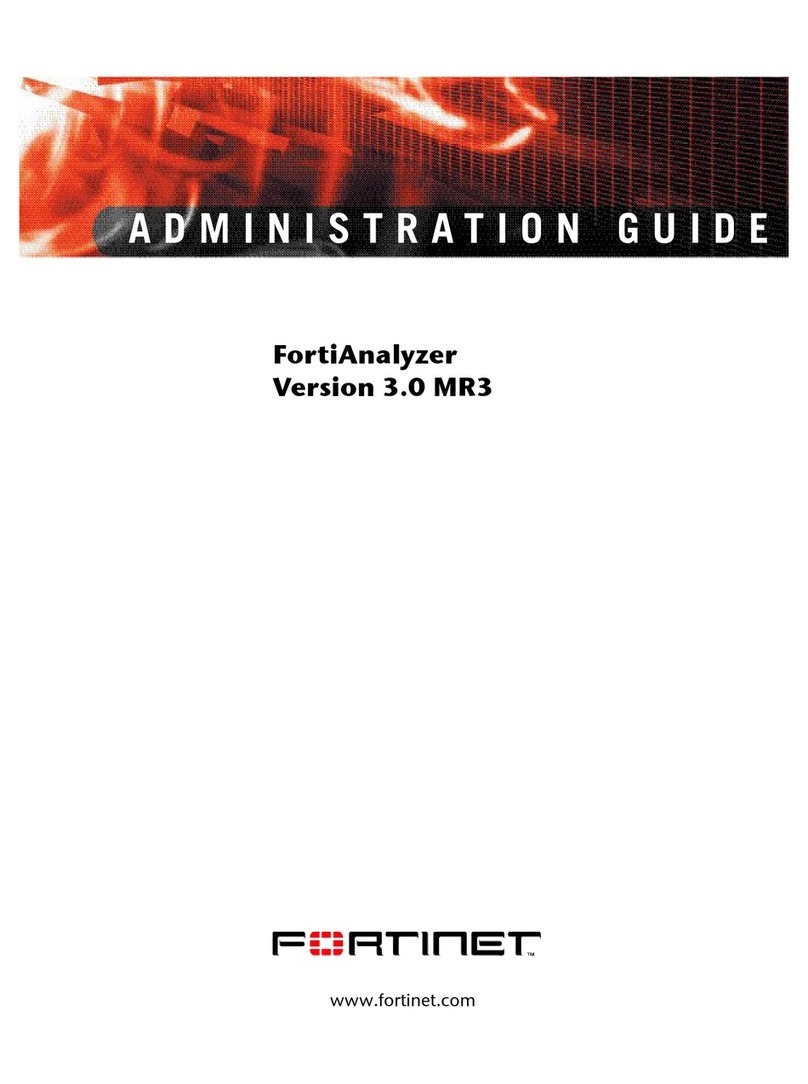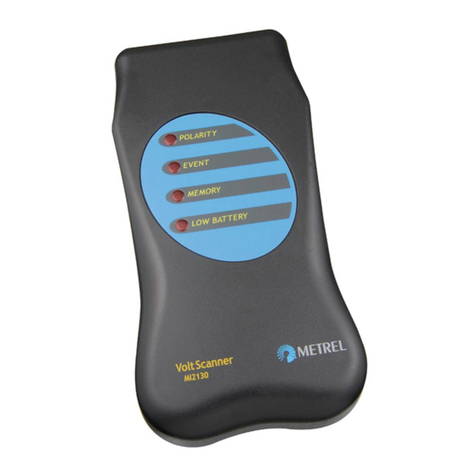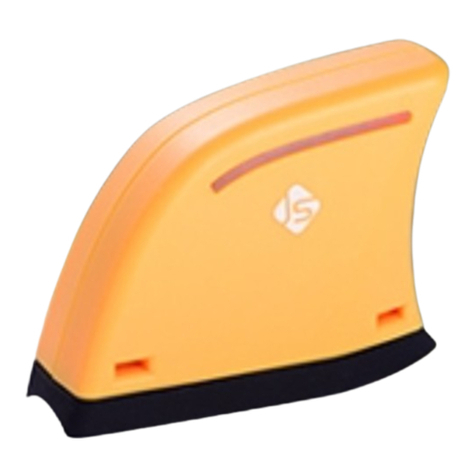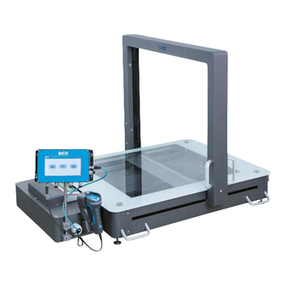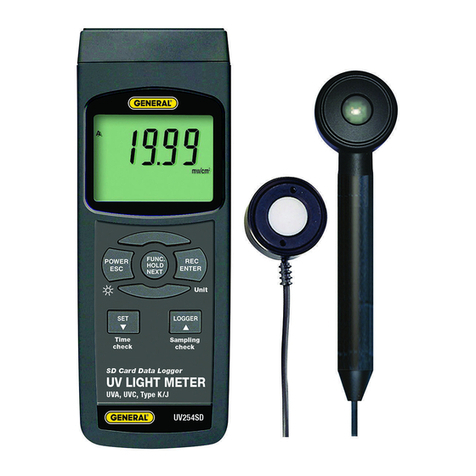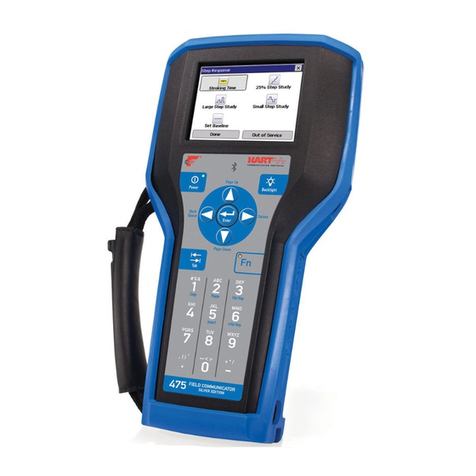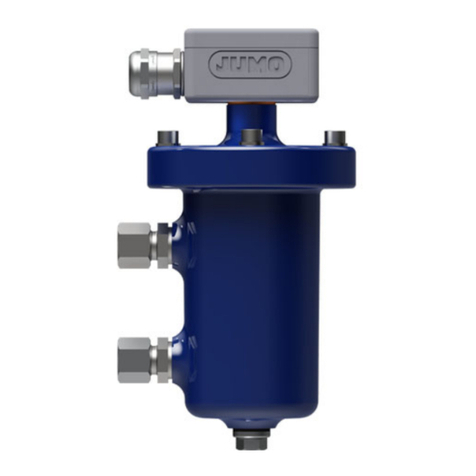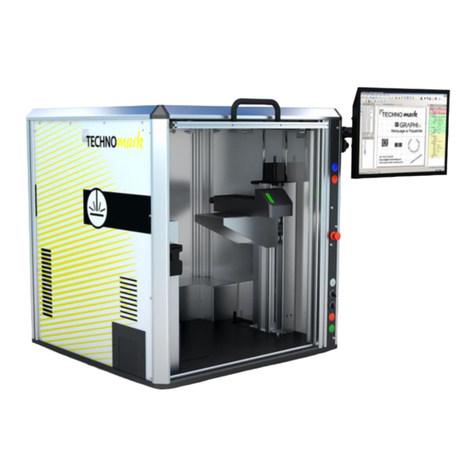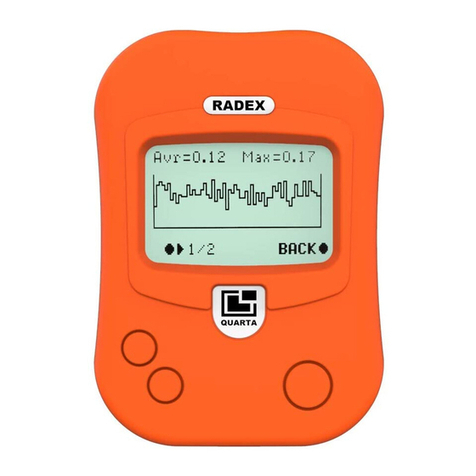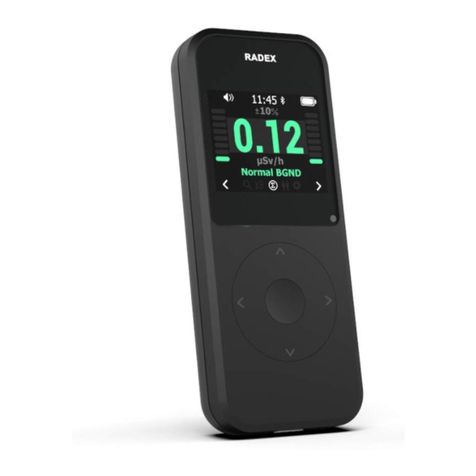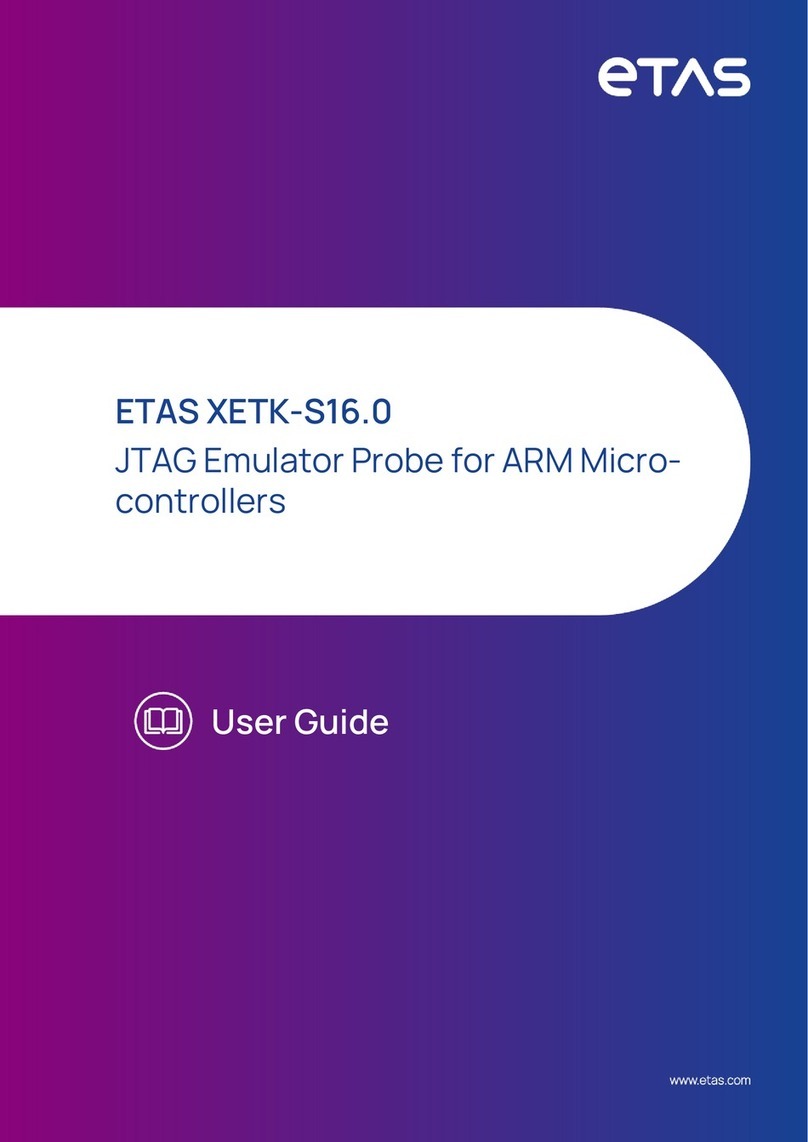EEZ RV EezTire T515 User manual

EEZ RV PRODUCTS
EezTire T515 SYSTEM
WIRELESS TIRE PRESSURE AND
TEMPERATURE MONITORING SYSTEM (TPMS)
Instruction Manual
Model No: TM-515T22/SP

23
TABLE OF CONTENTS
SYSTEM COMPONENTS - ANTI-THEFT SENSORS........................................ 4
SYSTEM COMPONENTS - FLOW - THROUGH SENSORS............................. 4
MONITOR COMPONENTS & ICONS .............................................................. 5
TPMS MAIN FEATURES.................................................................................... 5
Reduce Driving Risks.......................................................................................................................... 5
Improve Fuel Economy ..................................................................................................................... 5
Prolong Lifetime of Tires ................................................................................................................... 5
SYSTEM OVERVIEW ......................................................................................... 6
GENERAL INFORMATION................................................................................ 6
PRODUCT FEATURES....................................................................................... 7
Monitor Features ................................................................................................................................. 7
Sensor Features.................................................................................................................................... 8
Transceiver Features (optional part)............................................................................................. 8
STEP BY STEP SET UP INSTRUCTIONS.......................................................... 8
SETTING YOUR SYSTEMS ALARM PARAMETERS........................................ 9
Settings Sequence:
Choosing A Pressure Unit of Measure .......................................................................................... 9
Choosing A Temperature Unit of Measure ................................................................................. 9
High Pressure Parameter Front Axle .......................................................................................... 10
Low Pressure Parameter Front Axle ........................................................................................... 10
High Pressure Parameter 2nd Axle............................................................................................ 11
Low Pressure Parameter 2nd Axle .............................................................................................. 11
High Pressure Parameter 3rd Axle .............................................................................................. 11
Low Pressure Parameter 3rd Axle ............................................................................................... 11
High Pressure ParameterTow Vehicle ........................................................................................ 12
Low Pressure Parameter Tow Vehicle ........................................................................................ 12
High Temperature Parameter....................................................................................................... 12
PROGRAMMING SENSORS TO THE MONITOR.......................................... 13
Programming Sensors (Method 1 - Air Pressure Activation)............................................. 13
Programming Sensors (Method 2 - O the Vehicle: Flow-Through/T508) ................... 14
Programming Sensors (Method 3 - On the Vehicle: Flow-Through/T508) ................... 15
Monitor Display in Operating Mode ...........................................................................................16
MONITOR INSTALLATION............................................................................................. 17
SENSOR INSTALLATION................................................................................................. 19
DELETING SENSOR CODES FROM THE MONITOR.................................... 20
Delete a Single Sensor Code................................................................................................................. 20
Deleting all Sensors Codes.................................................................................................................... 20
OTHER FUNCTIONS ...................................................................................... 20
Normal Scrolling Display ................................................................................................................ 20
Backlighting ........................................................................................................................................ 20
Connecting/Disconnecting the Trailor ..................................................................................... 20
Charging the Monitor...................................................................................................................... 21
Viewing ID Code ................................................................................................................................ 21
OUT OF PARAMETER ALERTS........................................................................ 21
Monitor Alerts:
High Pressure Alert........................................................................................................................... 21
Low Pressure Alert ............................................................................................................................ 21
3
High Temperature Alert.................................................................................................................. 22
Fast Leakage Alert............................................................................................................................. 22
Sensor Low Battery Alert................................................................................................................ 22
REPLACING THE SENSOR BATTERY - ANTI-THEFT SENSORS.................. 23
REPLACING THE SENSOR BATTERY - FLOW-THROUGH SENSORS......... 24
REPEATER/SIGNAL BOOSTER (OPTIONAL PART - RP02-06) ................... 25
Recreational Vehicles, Tow Vehicles & Trailers
Placement Instructions........................................................................................................................... 25
Installation Instructions.......................................................................................................................... 25
Repeater Specications.......................................................................................................................... 26
REPEATER/SIGNAL BOOSTER INSTALLATION & PROGRAMMING (OPTIONALPART)
26
Big Rig & Owners of Multiple Trailers or Tow Vehicles
How to Operate.................................................................................................................................. 27
Entering Tractor & Trailor ID for the First Time....................................................................... 27
Monitor Sending Data to Repeater/Booster for the First Time........................................ 27
Repeater/Booster Sending Data to Monitor (For Trailor Exchange)................................28
REPEATER/BOOSTER ALERTS .................................................................... 28
High/Low Pressure & Fast Leakage Alerts................................................................................ 28
High Temperature Alert...................................................................................................................28
SPECIFICATIONS............................................................................................. 29
Monitor.................................................................................................................................................. 29
Sensors - Anti-Theft.......................................................................................................................... 29
Sensors - Flow Through .................................................................................................................. 29
Transceiver (optional parts)........................................................................................................... 29
TROUBLESHOOTING .............................................................................. 3034
CAUTIONS....................................................................................................... 35
LIMITED WARRANTY & GUARANTEE........................................................ 35
TIRE SENSOR PLACEMENT DIAGRAM ...................................................... 36

SYSTEM COMPONENTS: ANTITHEFT SENSORS
4
SYSTEM COMPONENTS: FLOW THROUGH SENSORS
MONITOR COMPONENTS AND ICONS
TPMS MAIN FEATURES
Reduce Driving Risks
It was reported that an astonishing 75% of all running tires in the USA are
under-inated and 70% of fatal trac accidents were caused by tire blow-
outs. With a Tire Pressure and Temperature Monitoring System (TPMS),
drivers are warned of abnormal tire conditions before it becomes dangerous.
Improve Fuel Economy
Today’s tire designs make visual inspection of deated tires very dicult.
Very often, a 30% under inated tire looks very much like a fully inated one.
A TPMS will make sure your tire pressure is at its proper level.
A 9 psi drop in tire pressure will cause approximately a 4% increase in fuel
consumption.
Prolong Lifetime of Tires
The following table shows a simple relationship between tire pressure and
tire lifetime:
5

67
SYSTEM OVERVIEW
This EEZ RV PRODUCTS EezTire T515/SP Tire Pressure and Temperature
Monitoring System (TPMS) is a heavy duty versatile system designed to
operate on a variety of vehicles. (i.e. Motor Coach, 5th Wheel, Travel Trailer,
Auto, Trailer, Big Rig, Farm and Mining Equipment).
The system comes with a monitor that can handle 22 wheels with pressures
up to 210 psi. The sensors are light weight and do not aect the tire balance
and have easy to change replaceable batteries. The system oers a method
of also dropping the towed vehicle and then picking it back up again when
connected.
The monitor scrolls automatically through each wheel measuring tire
pressure and temperature, displaying it on the monitor. Alarms can be
preset by the operator so visible and audible alarms can warn the driver of a
catastrophic failure (rapid air pressure loss), high or low pressures and high
temperature. The alarms and monitoring are sent wirelessly in real time to
the cab allowing the operator to monitor tires that are out of their vision. The
audible alarm eliminates the need to continually watch the monitor.
Tire Pressure can be displayed in PSI or Bar and temperature in Fahrenheit
(F) or Celsius (C). Pressure alerts can be set to a dierent pressure setting for
each axle, so additional towed trailers or vehicles are no problem. The high
ecient sensors can transmit to distances up to 53 feet without a booster
and are easy to install. If needed, an optional booster can be purchased from
your dealer or at www.eezrvproducts.com.
The monitor has its own rechargeable Lithium Ion battery pack and can be
used as a handheld wireless tire pressure gauge when the operator adjusts
the tire pressures. Sensors come with either the anti-theft security feature or
ow-through feature and the monitor comes with both an auxiliary charger
and a hard wire cable at no extra charge.
The EEZ RV PRODUCTS EezTire T515/SP TPMS System oers both easy
installation and one of the largest LCD display monitors on the market.
GENERAL INFORMATION
A tire professional or your owners manual should be used to determine the
proper tire pressure for your vehicle. Recommended operating tire pressures
should be set when the ambient temperature is low or cold.
Dramatic changes in tire pressure can occur because of; increased or
decreased ambient temperature, tire contact surface temperature, wheel and
axle loads, sun shining on a particular side etc. These and other conditions
should be taken into consideration when setting initial tire operating
pressures.
This system cannot warn you of side wall failures; however, it can supply you
with irregular pressures and temperature information that may help to
prevent this. If the monitor is shut o overnight simply switch the monitor
back on prior to departure and your real time tire pressures and
temperatures will be updated and typically appear on the screen within 5
to 10 minutes. Even if the monitor is in the sleep mode the system is always
monitoring and will alarm should any pressure settings or temperatures be
out of your set parameters.
The Schrader Valve (core - inside the valve stem) should be the correct size,
be in good condition and be able to be depressed fully to allow the release
of air to the sensor so it can operate. Some valve stem extensions may cause
inaccurate readings if they do not allow the sensor to operate correctly,
metal bodied stems or T-Valve type are recommended for best performance.
Should you have diculty with a pressure sensor not operating correctly we
recommend that you contact a tire professional to ensure that the tire stem
and Schrader Valve are installed and operating correctly. Do not use tire
sealants or balancing compounds that can enter the sensor body when using
this system. Over a period of time tires may loose pressure naturally, through
the tire itself or for other reasons such as rim leakage etc. However, after
the EezTire TPMS valve sensors (including locking mechanism, if tted) are
installed it is recommended that the sensor and valve stem be completely
covered in a soapy solution of 1 part liquid soap to 2 parts water, to see if
there are any air bubbles coming from the valve and sensor area indicating
that the tire is leaking air. If air bubbles are visualized in any of these areas,
the tire may deate. The wheel sensors are weatherproof and can be run in
the rain.
A tire professional should be consulted should any of these areas prove to be a problem.
Purchasers of this product should not solely rely on this tire pressure
monitoring system for safety and should check the condition and pressure of
their vehicles tires on a regular basis as described by the manufacturer of the
vehicle or tire manufacturer. Please note, the EEZ RV PRODUCTS EezTire T515/
SP TPMS System operates on an RF system, as with many RF tire systems this
system can occasionally suer from interference depending on the systems
location; thus causing the system to be inaccurate or not operate at all. Tire
pressures and temperatures are not the only things that can aect tire safety;
we suggest daily visual inspections and periodic checks by tire professionals.
PRODUCT FEATURES
Monitor Features
• Reliable and easy to install.
• Large 3 1/2 inch LCD screen.
• Built-in rechargeable lithium ion battery.
• Automatic light sensor and backlight.
• Built in motion sensor.
• Congurable high/low pressure warnings.
• Congurable high temperature warnings.
• Visible and audible alerts.

89
• Selectable pressure units.
• Can monitor in either standard or metric measurements (psi or bar/F or C)
• Monitors up to 22 tires maximum.
• Long range between sensors and monitor.
• Per axle measurements can be congured on the tractor.
Sensor Features
• Reliable cap sensors, easy to install.
• Water resistant.
• Replaceable sensor batteries.
• Fast leakage alert.
• Individually coded sensors.
• Anti-theft or ow-through design.
Transceiver Features (optional part)
• Maintains signal stability.
• Records sensor !D, trailer !D and tire pressure and temperature limits.
• Supports truck and trailer exchange.
• Transferable trailer sensor data between monitor and transceiver.
• Visible and audible alerts.
• Fixed alert for high temperature (194°F)
SYSTEM SETUP
This portion is designed to make the set-up of your new EEZ RV PRODUCTS
EezTire T515/SP TPMS System easier and faster.
Much of the information contained in this manual is found through real life
experience using the system and passed on to hopefully make the use of the
system easier for you.
Please read through the guide completely prior to starting. Complete set-up
should take approximately 20 minutes.
START YOUR SET UP HERE - Step by Step Instructions:
1. Unpack all of the components of your TPMS System and ensure it is
complete.
2. Take the number kit from the accessory pack and number all your
sensors as indicated below. (Hint: After affixing the number to the sensor take some clear nail
polish and paint over the number. This will help ensure it stays on in inclement weather conditions.)
3. On the diagram on the last page of this manual assign the numbered
sensors to each tire as they will be put on your rig and tow vehicle.
4. Program the alarm parameters using STEP 1: SETTING YOUR SYSTEMS
ALARM PARAMETERS
5. Program each sensor to the monitor using STEP 2: PROGRAMMING
SENSORS TO THE MONITOR
STEP 1: SETTING YOUR SYSTEMS ALARM PARAMETERS
(By Sequence)
Referto the diagramon the last pageof this manual whereyouwrote thesensornumberfor each tire.
1. Next to each axle write down what your tire pressure is by axle and calculate
what your alarm setting will be.
2. High Pressure setting will be (20% above axle tire pressure).
3. Low Pressure setting will be (10% below axle tire pressure).
Example: Front Axle Tire Pressure is: 100 psi
High Pressure Alarm Setting will be: 120 psi (100 psi x 1.20 (or 20%) = 120
Low Pressure Alarm Setting will be: 90 psi (100 psi x .9 (or 90%) = 90
These are industry standards for the initial set-up, some adjustment may be
needed after your rst trip. Every brand of tire operates dierently, when
some brands reach operating temperature the psi will increase 5 psi, other
brands may increase 20 - 22 psi. During your rst trip you will see if you need
to increase your High Pressure Alarm setting. For the temperature it is
recommended leaving it at the factory default of 158 degree F.
Choosing A Pressure Unit of Measure
1. Press the SET button and hold it approximately 3 seconds until you hear
the beep. You will rst see PSI or BAR (for metric) in the rst window. Use
the + or – key to scroll between the two. When the one you want to use
appears in the screen press and release the SET button. (Pressing and
releasing the SET button in this mode is like saying yes to what the
screen is showing you)
Choosing a Temperature Unit of Measure
2. It will automatically move to the next window which will show you F
(Fahrenheit) or C (Celsius) for the degree setting in the second window.
Use the + or – key to scroll between the two. When the one you want to
use appears in the screen press the SET button and release.

10 11
Setting High Pressure Alarm Parameter - Front Axle
3. Now the front axle should be ashing with the words High Pressure on
the bottom of the screen. Press the + or – keys to make the pressure
scroll up and down. Once you reach the High Pressure setting you desire
press the SET button and release.
NOTES:
1. You may notice when you attempt to scroll below 100 psi it will go to 102 psi and then
scrolls back to 210 psi. This is because the system is set up in two modules; 0-102 psi and
102-210 psi. In this case stop at 102 psi and press SET and release to go onto the next set
up. Once you have completed programming the other axles scroll back to those axles that
did not allow you to go below 102 psi. The second time the monitor will recognize you
want the lower module and allow you to scroll below 102 psi.
2. It will go to the next axle to repeat the process. It will show you all the tires and axles
even though they may not be utilized for your set up. If you have no tires on a particular
axle you can simply press and release the SET button to move on. Tires and axles with no
sensors will not show up on your screen when completed.
Setting Low Pressure Alarm Parameter - Front Axle
4. Now your front axle should be ashing with the Low Pressure showing
on the bottom of the screen. Press the + or – keys to make the
pressure scroll up and down. Once you reach the Low Pressure setting
you desire press the SET button and release.
Setting High Pressure Alarm Parameter - 2nd Axle
5. Now the second axle should be ashing with the words High Pressure on
the bottom of the screen. Press the + or – keys to make the pressure
scroll up and down. Once you reach the High Pressure setting you desire
press the SET button and release.
Setting Low Pressure Alarm Parameter - 2nd Axle
6. Now your second axle should be ashing with the Low Pressure showing
on the bottom of the screen. Press the + or – keys to make the
pressure scroll up and down. Once you reach the Low Pressure setting
you desire press the SET button and release.
Setting High Pressure Alarm Parameter - 3rd Axle
7. Now the third axle should be ashing with the words High Pressure on
the bottom of the screen. Press the + or – keys to make the pressure
scroll up and down. Once you reach the High Pressure setting you desire
press the SET button and release.
Setting Low Pressure Alarm Parameter - 3rd Axle
8. Now your third axle should be ashing with the Low Pressure showing
on the bottom of the screen. Press the + or – keys to make the
pressure scroll up and down. Once you reach the Low Pressure setting
you desire press the SET button and release.

12 13
When it comes to the tow vehicle there are two things to keep in mind: it
will show 3 axles and it will only allow you to set the High and Low Pressure
parameters the same for all 3 axles.
Setting High Pressure Alarm Parameter - Tow Vehicle
9. Now all three axles should be ashing with the High Pressure showing
on the bottom of the screen. Press the + or – keys to make the
pressure scroll up and down. Once you reach the High Pressure setting
you desire press the SET button and release. (Refer to the “Note” when selecting a
pressure below 102 psi)
Setting Low Pressure Alarm Parameter - Tow Vehicle
10. Now all three axles should be ashing with the Low Pressure showing
on the bottom of the screen. Press the + or – keys to make the
pressure scroll up and down. Once you reach the Low Pressure setting
you desire press the SET button and release.
Setting High Temperature Parameter - All Axles
11. Last, will be the Temperature setting, we recommend leaving it at the
default setting of 158 degrees. Press the + or – keys to make the
temperature scroll up and down.
At this time if you had any axles that would not allow you to program
below 102 psi scroll back to them by pressing and releasing the SET
button until you are back to the axle you need to adjust. Now the system
will allow you adjust it below 102 psi, adjust it to the desired psi and
repeat for any other axles that may need to be adjusted. To save the
data; press the SET button and hold it for approximately 6 seconds
until you hear the beep and it returns to the operating screen.
STEP 2: PROGRAMMING SENSORS TO THE MONITOR
•There are 3 methods of programming you can use, choose the one that is easiest for you. I prefer to
program the alarm parameters and sensors to the monitor at my table then walk out and install
the sensors on the tires (Method 2). This is the easiest way!
• • If tires are showing on your monitor the first time you turn it on these would be from
factory testing and are not your sensors. Note: If you would like to delete these press and hold the CODE
button for 3 seconds; use the +/- key to scroll to the tire showing on the screen, you will see a six digit code;
press and hold the SET button until you see this code change to FFF FFF. You have deleted the old code
from the tire position. You do not need to do this, when you program your sensor to the tire it will delete
the previous code and update the system with your new sensors code.
METHOD 1: Air Pressure Activation for T515 Anti-Theft Sensors Only
1. Using the switch on the left side center of the monitor, push it up to turn
the monitor on.
2. Wait for the screen to warm up, your monitor may or may not show tires
congured on the screen. If tires are showing the rst time you turn your
monitor on these would be from factory testing and are not your sensors.
(See • • on page 13 if you want to delete the factory test code)
3. Press and hold the CODE button on the lower right side down for 3
seconds until you hear the beep. At this time you will see all 22 tires on
the monitor screen and the right front tire should be ashing.
(Note: If a sensor is coded twice into the same position on the monitor, the previous setting will be
deleted automatically. Once you start the programming or set-up functions if you do not perform a task
in approx. 40 seconds it will time out and go back to the operating mode. If this happens you will have
restart the process with STEP 3.)
4. Following your diagram, hold the monitor approximately 1-6 inches from
the sensor as you screw the sensor onto the tire valve stem. You
will see the FFF FFF automatically change to the code as the air pressure
activates the sensor. If the code does not change within 25 seconds, back
the sensor o the valve stem and reattempt. * I set the monitor on top of the tire or on
the rim when I am screwing the sensor on the valve stem.
(We recommend using a little Anti - Seize Thread Lubricant on the valve stem to prevent corrosion do
to dissimilar metals. Use caution not to get any inside the sensor when installing. You can purchase the
Anti-Seize Lubricant at most auto parts stores.)

14 15
5. Use the + or – keys to scroll to the next tire you want to set up. The tire
which you are programming the sensor to the monitor for should be
ashing.
* Ensure the tire you want to program is ashing on the screen prior to screwing the next sensor on the tire.
6. Once all the tires (sensors) are programmed press the CODE button and
hold for approx. 6 seconds, until you hear a long beep. Your monitor
screen should now look like your rig conguration.
7. Release the CODE button, now your sensors are programmed. (Note:
if you see a sensor has dropped o after you have programmed them,
don’t panic. Merely repeat the steps starting at STEP 3 to reprogram the
missing sensor(s). Note: The same steps are used if you need to REPLACE a sensor.
Sensor code displayed on monitor.
(Every sensor has a unique code just like every
vehicle has a unique VIN number)
METHOD 2: Sensor O the Vehicle - Flow-Through and T515 Sensor
1. Using the switch on the left side center of the monitor push it up to turn
the monitor on.
2. Wait for the screen to warm up, your monitor may or may not show tires
congured on the screen. If tires are showing the rst time you turn your
monitor on these would be from factory testing and are not your sensors.
(See • • on page 13 if you want to delete the factory test code)
3. Lay the sensors out on the table in front of you as they will be installed
on the vehicle/s Hint: You can lay them on the diagram by the number if that is easier for you.
4. Press and hold the CODE button on the lower right side down for 3
seconds until you hear the beep. At this time you will see all 22 tires
on the monitor screen and the right front tire should be ashing.
The ashing tire icon is displayed together with the letters FFF FFF
for unprogrammed tire or sensor’s ID code for a programmed tire.
5. Use the + or – keys to scroll to the tire you want to set up. The tire which
you are programming the sensor to the monitor should be ashing.
(Right Front in this Case)
6. Hold the sensor so it is touching the monitor just below the SET
button. Turn away from the other sensors so their signals do not interfere
with your programming. You should see FFF FFF on the screen, if the
monitor shows a series of numbers and letters don’t worry these are
from factory testing. Press and release the CODE button; you should see
the numbers on the screen change. (This will be the sensor code).
Notes:
a. If the monitor does not receive the code within 6 seconds, an error message “Id LF”
(for Low Frequency) and the “Id Err” (for Error) will be displayed. If this occurs wait for
the ID ERR to clear the screen and repeat.
b. If a sensor is coded twice into the same position on the monitor, the previous setting
will be deleted automatically.
c. Once you start the programming or set-up functions if you do not perform a task in
approx. 40 seconds it will time out and go back to the operation mode. If this happens
you will have to restart the process with STEP 4.)
7. Use the + or – keys to scroll to next tire and repeat.
8. Once all the tires (sensors) are programmed press the CODE button and
hold for approx. 6 seconds, until you hear a long beep. Your monitor
screen should now look like your rig conguration.
9. Release the CODE button, now your sensors are programmed. (Note:
if you see a sensor has dropped o after you have programmed them,
don’t panic. Merely repeat the steps starting at STEP 4 to reprogram the
sensor.)
10. Place the sensors on the tires as numbered on your diagram.
(We recommend using a little Anti-Seize Thread Lubricant on the valve stem to prevent corrosion do to
dissimilar metals. Use caution not to get any inside the sensor when installing. You can purchase the
Anti-Seize Lubricant at most auto parts stores.)
Method 3: Sensor On the Vehicle - Flow-Through and T515 Sensor
1. Using the switch on the left side center of the monitor push it up to turn
the monitor on.
2. Wait for the screen to warm up, your monitor may or may not show tires
congured on the screen. These would be from factory testing and are
not the sensors you installed. (See • • on page 13 if you want to delete the factory
test code)
3. Place the sensors on the tires as numbered on your diagram.
(We recommend using a little Anti-Seize Thread Lubricant on the valve stem to prevent corrosion do to
dissimilar metals. Use caution not to get any inside the sensor when installing. You can purchase the
Anti-Seize Lubricant at most auto parts stores.)
4. Press and hold the CODE button on the lower right side down for 3
seconds until you hear the beep. At this time you will see all 22 tires on
the monitor screen and the right front tire should be ashing. The
ashing tire icon is displayed together with the letters FFF FFF for
unprogrammed tire or sensor’s ID code for a programmed tire.
5. Hold the monitor so the sensor is touching the monitor housing just
below the SET button. You should see FFF FFF on the screen, if the

16 17
monitor shows a series of numbers and letters don’t worry this is most
likely from factory testing. Press and release the CODE button; you
should see the numbers on the screen change.
Notes:
a. If the monitor does not receive the code within 6 seconds, an error message “Id LF” (for
Low Frequency) and the “Id Err” (for Error) will be displayed. A double-beep will be issued
and the red light goes out. Move the sensor closer to the monitor and repeat.
b. If a sensor is coded twice into the same position on the monitor, the previous setting will be
deleted automatically.
c. Once you start the programming or set-up functions if you do not perform a task in approx. 40
seconds it will time out and go back to the operation mode. If this happens you will have restart
the process with STEP 4.)
6. Use the + or – keys to scroll to next tire and repeat.
7. Once all the tires (sensors) are programmed press the CODE button and
hold for approx. 6 seconds, until you hear a long beep. Your monitor
screen should now look like your rig conguration.
8. Release the CODE button, now your sensors are programmed. (Note:
if you see a sensor has dropped o after you have programmed them,
don’t panic. Merely repeat the steps starting at STEP 4 to reprogram the
sensor.)
YOUR SYSTEM IS NOW SET-UP AND READY FOR USE
MONITOR DISPLAY IN OPERATING MODE
After the sensors have all been programmed and the system is in operating
mode the monitor display will automatically scroll through each monitored
tire one by one. The tire being transmitted will ash on the screen and the
pressure and temperature for that wheel will be displayed on the monitor.
When the monitor is initially turned on it may take up to 10 minutes for the monitor and sensors to sink up
before the pressure and temperature will show up on the monitor.
After this time if you see one sensor is still not transmitting the pressure and
temperature you may want to delete the sensor from the monitor and
reprogram.
If the tire still fails to indicate a pressure and temperature remove the sensor and back the Schrader Valve
(valve core) out approximately 1/8 to 1/4 turn and reinstall the sensor. This will ensure sucient contact and
air pressure to the sensor.
NOTES and RECOMMENDATIONS:
- There will be an audible single “chirp” and the tire will ash if the monitor
has not received a reading from that tire after 1 hour.
- You can also manually scroll through the tires one by one by pressing the
+ or - button. If you manually select a particular tire the monitor will
show its readings for 10 seconds.
- The monitor comes equipped with a light sensor, the backlight will
normally come on if the vehicle is in motion and the light level is low
enough. You may also wave your hand in front of the monitor to
manually activate the backlight or by pressing any button. It can be
turned o by pressing the + button for 3 seconds. The light sensor
is located on the lower left of the monitor, just left of the “LINK” button.
- The monitor comes with a built in motion sensor, it will go to sleep
(energy saver mode) if there is no motion of the vehicle detected for
approximately 15 minutes and wake up when it detects motion.
- It is recommended that the monitor is shut o when the system is not in
use or you are staying in the vehicle overnight.
- When external power is applied to the monitor it will override the
manual on/o switch on the left side. If you hard wire your system
charger to a “keyed” switch the system will go o when the keyed power
is turned o. If you are using the auxiliary charging cord you will have to
manually unplug the charger.
- You will get a longer service life from your monitors internal battery
if you unplug the external power source and allow the battery to
naturally deplete through normal operations every couple of weeks.
Factory Defaults
The factory default settings are as follows: High Pressure (175 PSI), Low
Pressure (100 PSI), Temperature (158 oF). To restore Factory Defaults: Turn o
the monitor; press the SET button and turn on the monitor at the same time.
The RED light will ash and factory settings will be restored.
Pressure Unit: PSI
High Pressure: 175 psi (12.1 BAR)
Low Pressure: 100 psi (6.9 BAR)
Temperature Unit: OF
High Temperature: 158 OF (70 OC )
MONITOR INSTALLATION
Your system comes with three mounting options: a plastic tower with suction
cup mount for window or dash, low prole mount for dash, low prole triangle
mount for dash. Some people prefer to use Velcro or the small bean bags used
for cellphones on their dash.

18 19
1. Install the monitor on the dashboard using the low prole mount or
mount it onto the windscreen or left side window using the suction
cup provided ensuring you do not obstruct the driver’s vision of the
road.
2. Plug the power adapter into the cigarette lighter or auxiliary power
outlet and connect the power cable to the monitor. It is recommended
using a “keyed” power source when hard wiring.
Metal Triangle Mount Bracket
If the bracket is needed, please follow the instructions below. Be sure not to
obstruct the driver’s vision when the monitor is installed.
Low Prole Mount
Angle can be adjusted by using any of the
three sets of holes in the back. You may want
to use Velcro on the bottom of the monitor
to prevent sliding.
SENSOR INSTALLATION
1. Remove the tire valve cap and mount the corresponding sensor on the
valve stem using the wrench provided.
2. The sensor is designed to be dicult to remove without using the
wrench provided.
3. Simply screw the wrench clockwise.
NOTES:
1. If you have trouble getting the wrench into the location you can unscrew the two halves of the
Anti-Theft housing , keep the bottom part of the housing in place on the sensor and screw the
sensor onto the valve stem by hand. Once the sensor is in place, pull the lower part of the housing
up and screw the top half of the Anti-Theft housing onto it. The Anti-Theft housing will now spin
when turned on the sensor. The reverse can be done to remove if necessary.
2. If you not need the Anti-Theft function, you may remove the Anti-Theft cover by simply
unscrewing the two halves. Mount the inner sensor on the valve directly. If you do not use the
Anti-Theft housing it is recommended to put a small bead of silicone around the seam where the
sensor unscrews to replace the battery. This will give extra protection against moisture entering
the battery housing in inclement weather.
Anti-Theft Sensor
Flow-Through Sensor

20 21
DELETING A SINGLE SENSOR ID
1. In operating mode, press and hold the CODE button for 3 seconds,
release it after the beep to enter the coding mode. A ashing tire icon
and ID code are displayed. Press the + or - button to select the desired
tire.
2. Press and hold the SET button for 3 seconds. A double-beep sound
will be issued and you will see FFF FFF after the sensor code is deleted
successfully. To return to operating mode, press and hold the CODE
button for 3 seconds until you hear a beep.
DELETING ALL SENSORS ID
1. In operating mode, press the CODE button to enter the coding ID mode.
A tire icon and sensor’s ID code will ash.
2. Press and hold the LINK button for 3 seconds. During this period, a
double-beep will be issued. The message DEL ALL will display on the
monitor.
3. Press the SET button to conrm the delete operation or press the
CODE button to cancel. If no further action is made after 3 minutes, the
operation is automatically cancelled and the system will return to
operating mode.
OTHER FUNCTIONS
Normal Scrolling Display
During normal operation, the monitor scrolls through and displays the tires
one by one for approximately 6 seconds. An audible single chirp will be
issued if one of the sensors data is not received by the monitor for more than
60 minutes. You can manually scroll through and select the tire by pressing
the +or -button. A manually selected tire will be displayed for 10 seconds.
Backlight and Motion Sensor
The monitor has a built in light and motion sensor. The backlight turns on
when it detects the vehicle is in motion and when it is dark enough or you
may wave your hand in front of the monitor to activate it. Press any button
on the monitor to turn on the backlight manually; to turn it o, press and
hold the +button for 3 seconds.
The monitor will enter sleep mode to conserve battery life if the motion
sensor does not detect motion for 15 minutes. It will come back to operating
mode when it detects the vehicle is moving again or other motion.
Connecting/Disconnecting a Tow Vehicle or Trailer (Drop image from the screen)
When the tow vehicle or trailer is not connected to the coach or towing
vehicle, press the LINK and -buttons at the same time, the tow vehicle or
trailer and tire icons will disappear. Press the LINK and +buttons at the same
time, the tow vehicle or trailer and its tire icons will reappear.
MONITOR ALERTS
High Pressure Alert
When the sensor detects high pressure in
a tire, it will send an alert to the monitor
immediately. HIGH PRESSURE will show
on the LCD and the corresponding tire
icon will ash. The audible alarm will be on
together with the ashing red light. Press
any button to turn o the alarm. However
the ashing red light and text will continue
until the problem is corrected.
Low Pressure Alert
When the sensor detects low pressure in
a tire, it will send an alert to the monitor
immediately. LOW PRESSURE will show
on the LCD and the corresponding tire
icon will ash. The audible alarm will be on
together with the ashing red light. Press
any button to turn o the alarm. However
the ashing red light and text will continue
until the problem is corrected.
Charging the Monitor
The lithium-ion battery inside the monitor, when fully charged is capable of
running for up to 60 hours. When the battery symbol appears, a recharge is
required.
Viewing a Sensor ID Code
In operating mode, press the CODE button to enter the set-up mode, the
monitor will display sensor’s ID code if the tire position is programmed with
a sensor, while it will display FFF FFF if the tire position is unprogrammed.
Press the +and -buttons to select the tires you want to review. It returns to
operating mode after approximately 40 seconds or by pressing the CODE
button and holding it down for approximately 6 seconds.
OUT OF PARAMETER ALERTS
The sensors send pressure and temperature readings to the monitor every 5
minutes. If any reading is out of the pre-dened parameter, the system will
interrupt the cycling and give you a real time alert, you will notice 3 things:
1. An audible alarm;
2. The red light on the lower right side of the monitor will ash;
3. The corresponding tire on the monitor will ash and a text message of
what is wrong will appear on the screen.
Press any button to switch the alarm o. However, the red light will not be turned
o until the correct pressure and temperature settings are restored to within range.

22 23
High Temperature Alert
When the sensor detects high temperature
in a tire, it will send an alert to the monitor
immediately. TEMP HIGH will show on
the LCD and the corresponding tire icon
will ash. The audible alarm will be on
together with the ashing red light. Press
any button to turn o the alarm. However
the ashing red light and text will continue
until the problem is corrected.
Fast Leakage Alert
When the sensor detects a rapid air loss in
a tire, it will send an alert to the monitor
immediately. FAST LEAKAGE* will show
on the LCD and the corresponding tire
icon will ash. The audible alarm will be on
together with the ashing red light. Press
any button to turn o the alarm. However
the ashing red light and text will continue
until the problem is corrected.
Sensor Low Battery Alert
When the sensor battery becomes
low, it will send an alert to the monitor
immediately. The LOW BATTERY ICON will
show on the LCD and the corresponding
tire icon will ash. The audible alarm will
be on together with the ashing red light.
Press any button to turn o the alarm.
However the ashing red light and icon will
continue until the problem is corrected.
* Fast Leak Alert Parameter is preset by the factory to alert when an air loss of 7.25 psi per minute occurs.
REPLACING THE SENSOR BATTERY T515 ANTITHEFT SENSORS
When the sensor low battery icon shows on the monitor and the
corresponding tire icon is ashing, the sensor battery needs replacement. A
CR1632 battery is recommended which operates at -40°F to 176°F. These can
be purchased at many hardware stores, Radio Shack or large Walmarts
(jewelry counter) when on the road. However, you will nd the best prices
on-line at either eBay, Amazon.com or on our site www.eezrvproducts.com.
Use the supplied wrench to
remove the sensor. Remove the cover and remove the sensor from the
anti-theft housing.
Use the wrench to hold the inner sensor and remove the upper portion of the sensor housing.
Take the battery out.
Replace a new CR1632 battery cell, ensure the positive + is facing upwards.
Check that the water-proof rubber seal is in its proper position. Screw the sensor cap back on. Reinstall the
anti-theft housing.

24 25
REPLACING THE SENSOR BATTERY FLOW THROUGH SENSORS
When the sensor low battery icon shows on the monitor and the
corresponding tire icon is ashing, the sensor battery needs replacement. A
CR1632 battery is recommended which operates at -40°F to 176°F. These can
be purchased at many hardware store, Radio Shack or large Walmarts
(jewelry counter) when on the road. However, you will nd the best prices
on-line at eBay, Amazon.com or on our site www.eezrvproducts.com.
Use the hex /allen wrench provided to remove the anti-theft screw and take off the sensor.
Remove the screws from the sensor cap and remove the cap.
Take the battery out.
Replace a new CR1632 battery, ensure the positive+ is facing upwards.
Check that the waterproof rubber seal is in its proper position. Screw the sensor cap back on.
REPEATER/SIGNAL BOOSTER INSTALLATION OPTIONAL PART RPO206
Recreational Vehicles, Tow Vehicles, Trailers and Tractor Trailer *
* (If you have a Tractor Trailer (Big Rig) that does drop and pulls of multiple trailers
you need to use the next section on page 26 because it requires a link function.)
The Repeater/Booster is designed to amplify the signal from your TPMS
system sensors. In situations where length or interference prevents your
monitor from receiving a signal, the Repeater/Booster increases the sensors
transmitting distance and helps overcome outside or electronic interference.
This should not be needed to monitor distances of 53 feet or less. However,
some Diesel Pushers experience diculties do to the amount of electronic
components in the engine compartment. As well as where sensors are
shielded by bodywork etc. causing sensor signal strength to be reduced and
where extremely cold temperatures may reduce sensor battery power. The
optional signal Repeater/Booster can be ordered separately and is available
at www.eezrvproducts.com.
The booster should be installed as low as possible on the rear of the towing
vehicle or at the front of the trailed vehicle. The hard wired booster should
have 12V DC power when the vehicle is moving. The red cable is + and the
black – Hint: Most people install them into their aft compartment or closet in the coach and wire it
into the compartment or closet light. By placing it on the coach you receive the advantage of the
Repeater/Booster even when your tow vehicle is not connected.
PLACEMENT INSTRUCTIONS
Motor Coach Placement: It is recommended to install the Repeater in an
outside - aft compartment or in your rear closet.
Fifth Wheel Placement: It is recommended to install the Repeater in an out-
side compartment under the front bed area.
INSTALLATION INSTRUCTIONS
Be sure to wire the Repeater into a 12V power source that will be “on”
during vehicle operation. The Repeater will be on as soon as it is connected
to power. The red light stays on when power is connected and ashes 3
times during receiving and transmitting.

26 27
REPEATER SPECIFICATIONS
Operational Temperature -4°F to 176°F
Storage Temperature -22°F to 185°F
Working Voltage 12 to 24V
Transmission Power <18dBm
Transmission Frequency 433.92MHz
Size 91(L) x 38(W) x 15(H) mm
Weight 1.48 ounces
REPEATER/SIGNAL BOOSTER INSTALLATION OPTIONAL PART RPO206
for
TracTor/Trailer(Bigrigs)ThaTdodropand pullsof mulTipledifferenTTrailers
A Repeater/Booster (purchased separately) allows sensor information to be
transferred to the tractor’s monitor when trailers are changed. A Repeater/
Booster must be installed on each trailer where it acts as a data exchanger as
well as a signal booster. For best performance, install the Repeater near the
front of the trailer.
Remark: To ensure better performance, please install the repeater outside
between the front tractor and towed trailer.
• Within a eet of trucks, trailers are often interchangeable with many tractors.
• A Repeater/Booster allows data from the new trailer to transfer to the tractor’s
monitor without having to enter all trailer’s sensor codes all over again.
IMPORTANT
1. Please read instructions before installation.
2. Repeater should be mounted securely.
3. The Repeater is water and dust resistant.
4. Minimize the amount of metal in mounting area.
5. Ensure all wires are mounted securely.
6. Verify Repeater is operating after installation.
HOW TO OPERATE
The Repeater/Booster is active as soon as it is connected to power. The red
light will stay on when power is connected and ash 3 times during receiving
and transmitting.
If the tractor needs to change trailers, follow the steps below to transmit the
trailer sensor data to the monitor.
Entering Tractor & Trailer ID for the First Time
1. In the operating mode press the LINK button on the lower left side of
the monitor. A six digit ID will be displayed for the current tractor.
2. Press the LINK button again, it will display the six digit ID of the trailer.
3. Press the LINK button for a 3rd time, the system will enter the tractor
ID coding mode.
4. Press the LINK button for the 4th time, the system will enter the trailer ID
coding mode.
5. Press the +or -buttons to scroll through numbers from 0-9. Press the
CODE button to set the digit and move the cursor to the next digit.
6. Press and hold the CODE button for 3 seconds to store the ID. If no
action is taken for 1 minute, the system will return to the operating mode
without making any changes.
Monitor Sending Data to Repeater/Booster for the First Time
If using the Repeater/Booster for the rst time, you will need to code all the
sensors, input the trailer ID, set the high/low pressure alerts and send the
trailer data to the Repeater/Booster.
1. In operating mode, press and hold the LINK button on the monitor for 6
seconds to enter sending mode. Do not release it after you hear the 1st
beep. A ashing SEND will be displayed on the monitor.
2. Press and hold the button on the Repeater/Booster for 3 seconds until
a beep is issued. The monitor will now send the sensor IDs, pressure and
temperature data and the trailer ID to the transceiver. On successful
transmission, the monitor will issue a long beep together with trailer ID
and tire icons.
3. If there is an error, or if the Repeater/Booster does not receive the data
within 2 minutes, the monitor will issue a double-beep and a ashing

28 29
FAIL will be displayed on the monitor.
4. Press any button or wait 3 minutes to return to the operating mode.
Note: The Repeater/Booster can only store the latest trailer's data; it will automatically update the data if
the data is received from the monitor.
Repeater/Booster Sending Data to Monitor (For Trailer Exchange)
1. Press and hold the button on the transceiver for 3 seconds until you
hear the 2nd beep and the LED will be lit.
2. Press and hold the LINK button for 3 seconds within 2 minutes. All the
tire icons will be displayed on the monitor with a ashing ACCEPT
message. Here the system enters the receiving ID mode.
3. The transceiver will send the sensor IDs, pressure and temperature data
and the trailer ID to the monitor.
4. On receiving the data, the monitor will display all the tire icons in the
trailer and the trailer ID. The trailer icon will ash for 3 minutes then exit.
Press any button within that 3 minute period to escape and cancel the
operation.
5. If there is an error, or if the Repeater/Booster does not receive the data
within 2 minutes, the monitor will issue a double-beep and a ashing
FAIL will be displayed with the trailer tire icons.
6. Press any button or wait 3 minutes to return to the operating mode.
Note: The transceiver can only store the latest trailer's data even if no sensor data was recorded for tires in
the trailer it will automatically update the data if the data is received from the monitor.
REPEATER/BOOSTER ALERTS
High/Low Pressure and Fast Leakage Alerts
When the sensor detects high/low pressure abnormalities and fast leakage, it
will send an alert to the Repeater/Booster immediately. The audible alarm will
be on together with the ashing red light. Press the button on the transceiver
to turn o the alarm. However the ashing red light will continue until the
problem is corrected.
High Temperature Alert
The Repeater/Booster has a xed temperature alert at 194°F/90°C. The
sensors send the temperature readings to the transceiver every 5 minutes.
If the temperature is above 194°F/90°C, an audible alarm will be on together
with the ashing red light. Press the button on the transceiver to turn o the
alarm. However, the ashing red light will continue until the temperature is
dropped below 194°F/90°C.
SPECIFICATIONS
Monitor
OPERATIONAL TEMPERATURE -4°F to 176°F
STORAGE TEMPERATURE -22°F to 185°F
CHARGER INPUT VOLTAGE DC 8 to 30V
TRANSMISSION FREQUENCY 433.92 MHz
SIZE 116 (L) x 68 (W) x 25 (H) mm
WEIGHT 4.87 ounces
Sensors - Standard
OPERATIONAL TEMPERATURE -40°F to 176°F
STORAGE TEMPERATURE -40°F to 185°F
PRESSURE RANGE 0 to 13 bar, 0 to 188 psi
PRESSURE ACCURACY ++1.5 PSI +0. BAR
TEMPERATURE ACCURACY ++5 °F
TRANMISSION POWER <10dBm
TRANMISSION FREQUENCY 433.92 MHz
BATTERY LIFE 3-4 Years (CR1632 -40°F to 176°F)
SIZE diameter 22.6 mm height 22.6 mm (without antitheft housing)
diameter 28 mm height 24 mm (with antitheft housing)
WEIGHT .5 ounces (without antitheft housing)
.63 ounces (with antitheft housing)
Sensors - Flow Through
OPERATIONAL TEMPERATURE -40°F to 176°F
STORAGE TEMPERATURE -40°F to 185°F
CHARGER INPUT VOLTAGE DC8 to 30V
TRANSMISSION FREQUENCY 433.92 MHz
SIZE 116 (L) x 68 (W) x 25 (H) mm
WEIGHT .78 ounces
Repeater/Signal Booster (optional parts)
OPERATIONAL TEMPERATURE -4°F to 176°F
STORAGE TEMPERATURE -22°F to 185°F
WORKING VOLTAGE 12 to 24V
TRANMISSION POWER <18dBm
TRANMISSION FREQUENCY 433.92 MHz
SIZE 91 (L) x 38 (W) x 15 (H) mm
WEIGHT 1.48 ounces

30 31
TROUBLESHOOTING & FREQUENTLY ASKED QUESTIONS:
1. What does it do?
Answer: Measures the air pressure and temperature within the tire to
ensure your tires are operating within safe parameters.
2. How does it work?
Answer: Tire pressure monitoring systems continuously monitor the
pressure in the tires through sensors located on the valve stem. The
information collected by the sensors is transmitted to an
on-board monitor that displays the tire data and warns the driver when
tire pressure or temperature is outside of the preset level.
3. What is the advantage of tire pressure monitoring system?
Answer: Under-inated tires need more fuel then properly inated tires.
The system in most cases will notify you of an impending problem prior
to a blow out. It will save you money, while providing peace of mind
while driving.
4. Is low tire pressure easily detected by eye?
Answer: Under inated tires are visually dicult to detect. It is
recommended that tires are inspected and checked monthly with an
accurate gauge. The TPMS is not intended to be a substitute for regular
tire maintenance.
5. Why does tire pressure change during driving?
Answer: Many factors aect tire pressure including ambient temperature
changes, road conditions and tire damage such as punctures. Tire
pressure drops about 1 psi for every 10 degrees F drop in ambient
temperature. Additionally, tires lose as much as 1.5 psi per month as air
escapes the tire and rim naturally.
6. Why there is no pressure and temperature readings on the LCD,
only tire icon ashes?
Answer: The sensors transmit the pressure and temperature every 5
minutes. The monitor will stop showing the pressure and temperature if
it doesn’t get the signal from the sensors for over an hour.
7. What happens if I remove the sensors from the wheels?
Answer: You will get a warning on your display screen. There is no way
to rid of this warning except delete the sensors CODE on the monitor.
As the system cycles it will warn you each time it tries to pick up a signal
from that sensor.
8. How do I turn o the “low pressure” warning on the monitor?
Answer: Press any button will stop the audible alarm, you will need to
inate your tires to the appropriate pressure to stop the red light and
text warning.
9. My TPMS warning light comes on when I start my car, but after a few
minutes of driving, it turns o.
Answer: In cold weather, the sensor reads a lower PSI. As you drive,
the air within your tires warm up, and thus the pressure is also increased.
10. I just lled my tires with air a few weeks ago and it is showing me
that I have low pressure.
Answer: A change in climate can aect the readings of the sensor
because of the change in pressure of the tire. If it has only been a short
period of time you may want to verify the tire pressure with a gauge to
determine if it is a leak or a faulty reading.
11. How is the accuracy of the temperature readings on external
sensors?
Answer: There will be some dierentiation between the actual inside
temperature and the sensor reading do to cooling as the air passes to
the sensor. However, it will still be an indicator of a tire heating up do to
air loss, soft side wall, a brake drum dragging or a bearing seizing and
heating up the rim.
12. If one sensor in a kit stops working, is it possible to replace a
sensors alone?
Answer: Yes, each sensor has a unique ID CODE; just program the
new sensor to the monitor, the new sensor will replace the old sensor
automatically.
13. Do I need to re-install the sensors after tires rotation?
Answer: NO. The sensor should be removed from the tire prior to
it being moved. As long as the sensor is replaced on the position no
reprogramming is required.
14. Can I combine sensors or boosters from other manufactures with
the EEZ RV TPMS PRODUCTS System?
Answer: It is not recommended to mix and match components from
other systems. We cannot guarantee components from other systems
will work properly or at all with each other.
15. Is it possible that sensors interfere with each other?
Answer: As each sensor transmit the signal every 5 minutes, and sensors
transmit separately. It only takes very little time to transmit signals, then
there is extremely low probability that sensors interfere with each other.
16. What’s the transmitting distance from sensors and monitor?
Answer: The TPMS transmitting distance for long vehicles can be up
to 53 ft. This may vary depending on the size of the vehicles, electronic
packages and amount of metal between the sensor and the monitor.
We recommend you test the system before departing, but often this
interference is not noticed until after the vehicle is under operation.
17. Is signal booster available?
Answer: Yes, we can provide an optional signal booster for long

32 33
vehicles if users want to make sure the monitor can read all sensors
information. You may order an optional Repeater/Booster on our site at
www.eezrvproducts.com.
18. Can I reset the monitor to factory settings?
Answer: Yes, to restore factory defaults, turn o the monitor, press the
set button and turn on the monitor at the same time. The red light will
ash and factory settings restored.
19. Do I need a signal booster (transceiver)?
Answer: The transmitting range for the EEZ RV PRODUCTS EezTire
TPMS System sensors is around 53 ft., consideration should be taken
for inner dual wheels, overhanging body work, metal tinted windows,
the size of the tow vehicle, and the coaches electronics package, etc.
which can block or impede the sensors signal strength.
20. Does this system measure temperature as well as pressure?
Answer: Yes, unlike some systems from other suppliers that just measure
pressure the EEZ RV PRODUCTS EezTire TPMS System measures internal
tire air temperature and has an over temperature alarm. This can be an
advantage on vehicles that are stored for long periods of time where
brake calipers can stick after the rst brake application and cause a
dragging brake situation. As well as a back up to the low pressure
alarm as increased internal tire temperature is caused by low or reduced
air pressure.
21. I am having CODE setting issues, what can cause those?
Answer: Coding issues can be caused by incorrectly sized or bent valve
actuators (Dill Valve) or valves torque to tight or to loose in the tire valve
stem thus not allowing the sensor to operate. For issues coding sensors
on a tire with valve extenders, the sensor should be tested on a tire valve
with no extender to help isolate the problem.
22. I have an alarm, what should I do?
Answer: First, pull over safely to the side of the road. Determine which
wheel has an alarm, by checking the monitor icons; determine what type
of alarm you have. It could be a leaking tire, a tire that has over pressure
and too much air in it related to your base pressure setting, this can
happen after a long run on a hot day, it could be an overheating
situation etc. By checking the operating instructions you can see the
dierent monitor icons that are associated with each condition, a
ashing red light may or may not mean you have a deation, each alarm
icon tells you what the problem is. You will need to x the problem
before the red light will stop.
23. What is the Sleep Mode?
Answer: If the monitor is motionless for more than 15 minutes (vehicle
stationary) it will shut down to save the battery. When it detects motion
again it will beep and the screen will come to life signifying it has come
out of sleep mode. If the monitor is shut o overnight, simply switch
the monitor back on prior to your departure and your real time tire
pressure and temperatures will be updated in around 5 minutes
on the monitor. Even if your monitor is in the sleep mode the system
is always monitoring your tires and will alarm should any pressure or
temperature become out of your set parameters.
24. I am getting a Sensor Low Battery alarm, what should I do?
Answer: Eventually all batteries lose power or die. The EEZ RV
PRODUCTS sensor has replaceable batteries that can be easily replaced
whenever needed. Please see above for detailed directions. The battery
is a CR1632 watch type battery available from jewelry stores, electronics
stores or on-line. On the road, a Walmart jewelry counter is the cheapest.
25. How can I test the system?
Answer: The system should be frequently tested for fast leak operation.
The monitor should be placed in the driver’s location and sensors
unscrewed then tightened one at a time. The fast leak alarm should
operate and then reset on the monitor.
26. Do I need a special tool to install the sensors?
Answer: The EEZ RV PRODUCTS EezTire System comes with a
complimentary Anti-Theft System on each sensor. In order to install a
sensor you will have to use one of the 2 wrenches provided. You can
easily remove the Anti-Theft housing by unscrewing the two halves
of the Anti-Theft Housing; this will allow you to install the sensor by
hand with no wrench. This can be benecial when installing a sensor on
your inside dual.
27. Can I set dierent pressures for each tire or axle?
Answer: Axles can be set to a dierent pressure, for tow & towed
vehicles.
28. Can I use tire valve extensions?
Answer: Most tire valve extenders work ok, however if you have
problems with sensors mounted on extenders, test the sensor on a
regular valve stem location to see if it is a sensor problem or an extender
problem. Alarms can sometimes be caused by loose extender
connections.
29. How accurate is the system?
Answer: Our sensors are very accurate and any gauge readings should
bemade after resetting the sensors. Measurements of 1 psi need
a controlled laboratory type system to be accurate. The tire pressure is
accurate within +/- 1.5 PSI. Temperature is accurate to within +/- 5
degree F. The pressures and temperatures can vary dramatically from
wheel to wheel depending on many factors, such as sun shining on one
side, vehicle load, castor/ camber/alignment/brake temps. Even race
cars turning left all the time generate higher pressures and temps on
one side. Tire gauge accuracy can vary wildly and their quality is
not dependent on their cost. Temperature compensation is a

34 35
requirement in a good gauge. (Gauges that read the same at -40 &
110 degrees) slide type gauges that rely on friction are often inaccurate.
30. How much air do I put in my tires?
Answer: Always set the monitor pressure to the same as the cold ination
pressure. As an example some people set the monitor at 100 psi and
then put 105 psi in the tire for good luck, by doing this the chance of
over pressure alarms is increased.
31. I get an alarm when I have been stopped for a while?
Answer: In extreme cases it is possible to get a slow leak alarm after
the vehicle has been pushed hard and the tire pressure has dramatically
increased and upon stopping the tire cools quickly and the pressure
drops simulating semi rapid air loss. This situation is often caused by
high moisture content in the air in the tire.
32. How is my monitor powered?
Answer: The monitor is powered by an internal rechargeable battery
which holds a charge up to 60 hours before requiring recharging. A cigar
lighter cord AND hard wire kit comes with the base system, this means
you can take the monitor in your hand around your vehicle for sensor
setup and tire pressure adjustment, it is like having an electronic tire
gauge.
33. Does the system come with a warranty?
Answer: Yes, it comes with a 3 year limited warranty on defective parts
except batteries. Please see warranty section for full details.
34. Do I have to enter special CODEs for each sensor on set-up?
Answer: Each sensor comes pre programmed with its own unique CODE,
for sensor set up the monitor detects each sensors CODE when they are
installed.
35. Is there anything special I need to do for winter storage?
Answer: It’s a good idea to remove the sensors and monitor from your
vehicle if parked for an extended time, especially in cold weather. Store
the system in a warm location. Mark each sensors wheel position or
store them in an egg carton so they can be replaced in the same wheel
position to avoid having to do a new set up. Sensors use minimal power
when they have no pressure on them.
CAUTIONS
1. The monitor should be installed inside the vehicle where it does not aect
normal driving.
2. The monitor should be well xed to avoid falling o during driving.
3. After the sensor installation, it is highly recommended to check for any air
leakage.
4. Regular tire inspection and maintenance is still necessary.
5. After the system is installed correctly, the driver does not need to stare at
the monitor all the time while driving. Alerts will be issued when
abnormal conditions are found in the tires.
*Information in this manual is subject to change without notice.
LIMITED WARRANTY & GUARANTEE
Please contact the dealer you purchased it from to handle your warranty
or guarantee issues. EEZ RV PRODUCTS will, within 36 months from date of
original purchase, repair or replace free of charge any defective component
(except batteries) which upon careful inspection is found, in our sole
judgment, to have material or manufacturing defects, provided it is received
freight prepaid, accompanied by the original purchasers sales slip and an
authorized Return Merchandise Authorization number (RMA #.). If you
purchased your unit directly from EEZ RV PRODUCTS you may obtain an RMA
# by emailing customerrelations@eezrvproducts.com.
DISCLAIMER OF WARRANTY: The warranty applies to the original purchaser
only. The warranty does not carry over nor is it transferable to another party.
Neither the seller nor the manufacturer will be liable for any loss damage or
injury directly or indirectly arising from the use or inability to determine the
use of this product. Before using, the user shall determine the suitability of
the product for its intended use, and the user shall assume all responsibility
and risk in connection herewith.
EEZ RV PRODUCTS, LLC • PO Box 25766 • Yuma, AZ 85367
United States
www.eezrvproducts.com
© Copyright EEZ RV PRODUCTS
All Rights Reserved

36
Tire Pressure (cold)
Tire Pressure (cold)
Tire Pressure (cold)
Tire Pressure (cold)
High Parameter Setting
Low Parameter Setting
High Parameter Setting
Low Parameter Setting
High Parameter Setting
Low Parameter Setting
High Parameter Setting
Low Parameter Setting
rev. 1082014
Table of contents

